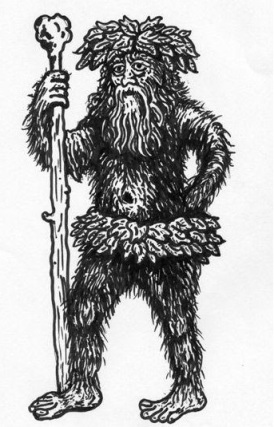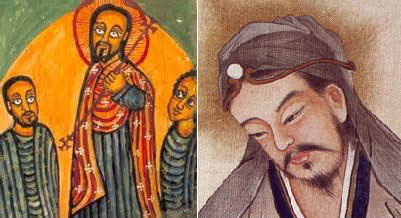So, as I’m sure most of you have heard, Santa Claus and Jesus are both White. They just are. And these are historical facts.

Megyn Kelly.
Or so proclaimed Fox television personality Megyn Kelly on her show The Kelly File, while discussing an article by Slate contributor Aisha Harris proposing that the beloved American icon be “made over” in a more culturally neutral manner. (Harris’s suggestion is a cartoon gift-bearing penguin complete with red suit and obviously fake beard.)
What ensued was a predictable lampooning by late-night comedians and news commentators, followed by Fox News’ just as predicable recalcitrant dismissal of a “liberal media’s” obsession with race and race-baiting. For her part, Ms. Kelly refused to apologize for her position, calling the entire episode “tongue-in-cheek,” though she did acknowledge that the issue of Jesus’ ethnicity is “unsettled.”

Harris’ Santa (illustration by Mark Stamaty).
There are many issues here that deserve commentary and discussion, not the least of which is Ms. Harris’ initial suggestion that an ethnically-neutral Santa Claus is much better suited for a multi-ethnic culture like that of the contemporary United States than the image of fat white man landing on rooftops and essentially performing what would be interpreted as “breaking and entering” in most legal jurisdictions. (And at least one comedian has suggested the ramifications for a black counterpart, given the Stand Your Ground laws in places like Florida.)
But I, like most in the entertainment and media industries, am more interested in what Kelly said, and how she said it, than in what precipitated it.
Kelly, of course, was simply pointing out what most Americans probably assume: Santa Claus as a fictionalized character is based on the historical fourth century Christian bishop Saint Nicholas of Myra. Santa has always been portrayed as a white man because, duh, his likeness is based on a real white man. The notion that he can be portrayed any other way than that of mainstream American culture and its hegemonic ethnicity (white) is practically unthinkable—at least by white folks in the mainstream.
In fact, when watching the video from the show, it is more Kelly’s insistence of the brute factuality of Santa’s (and Jesus’s) ethnicity that is so problematic—and not necessarily her position.
And on this subject, a few ideas deserve discussion.
First and most obvious is that what the historical Saint Nicholas and Jesus both share is, if not a common ethnicity, then at least a common geography and culture—that of the Hellenistic Near East. And while Nicholas was most probably a Greek from “Asia Minor,” and Jesus a Palestinian Jew, neither of them would have considered himself “white”—and would probably not be considered so by today’s use of the term. So if Santa Claus is simply a reinterpretation of the Anatolian bishop Nicholas of Myra, then Ms. Kelly is mistaken: neither he (nor Jesus) is white.
They just aren’t.
But, without getting into the specifics, our Santa Claus’s development most probably owes more to Pagan characters, practices, and legends than he does to the Christian bishop of Myra. And so, arguably, on this point, Kelly is correct: Santa Claus, inasmuch as he evolves from Germanic mythology, is “white” or Northern European (though the same cannot be said for Jesus).

A Medieval European “Wild Man.”
Of course, the real issue in all of this is the assumption that Santa is white—must be white, can only be white—whether rooted in history or mythology. And that is the assumption of hegemony: Where whiteness is the presumed sole and legitimate norm. Where the way things are is the way they have been and should be.
And pointing this out to someone who is oblivious to the ubiquity of whiteness in our culture can be awkward, unsettling, and even shocking.
Hence the insistence that Santa, like Jesus, is white—without any thought or consideration that such a proclamation may be controversial or that it could possibly be historically and culturally conditioned—tells us more about the speaker, her audience, and our culture than it does about either Santa or Jesus.
But this is not to belittle Ms. Kelly or chasten her about her firmly-held beliefs and ethnic identity. For the real “White Man’s (sic) Burden” is not to rule over and “civilize” the non-White world, but rather to recognize and confront examples of “White Privilege” in our pluralistic and multi-ethnic culture. And while there are much more important aspects of white privilege in present day America (like being arrested, prosecuted, convicted, and sentenced to jail far less often than non-whites for similar crimes), the ubiquity of whiteness as the aesthetical norm is not to be dismissed.
But this is easier said than done, since, while the ubiquity of whiteness is quite obvious to most non-white folks, it tends to be invisible to most whites.
And the same thing that happened to Ms. Kelly happened to me, though I was seven years old and in the second grade at the time.
I had the same reaction to the “Black Santa” that my African-American teacher Mrs. Watson had put up on her classroom wall: “Santa Claus is not black. He’s white,” I thought to myself, aghast at the suggestion. Luckily, I didn’t have a television show to proclaim this, and didn’t actually articulate it to any of my classmates either.
But the memory has stayed with me—as one where, for the first time, I was confronted with the hegemony of my own culture: me, a little white boy bused from my mostly white neighborhood to school in the projects: a minority among minorities, but whose whiteness was still the norm.
Or should be, as I mistakenly assumed then.

Still from the Good Times episode “Black Jesus” (1974).
And around the same time (1974) and in much the same way, I was confronted by the “Black Jesus” episode on Good Times, where JJ had used Ned the Wino as the model for his painting of the Christ, since—being passed out in the gutter—he was the only one who could hold the pose long enough for JJ to paint.
Much later, of course, I was confronted by a long history of Jesus being portrayed in the varying ethnicity of the portrayers—across the centuries, from Asia to Africa to Europe and the Americas.

Jesus in Ethiopian and Chinese depictions.
And then by the African-American Liberation Theologian James Cone’s insistence that “Jesus is a black man,” in that, according to Christian theology, God comes to his people in the guise of the most repressed and outcast among us. And in the United States, the reasoning goes, who has been more marginalized than the African slave?
But, arguably, I may not have been as sympathetic and understanding of art history or liberation theology had I not first been confronted in the privileged place of my whiteness in American culture by folks like Mrs. Watson, and the producers, writers, and cast of Good Times.
So what is troubling in Ms. Kelly’s remarks is not her assumption that both Santa and Jesus are white—but her insistence that they are, an insistence that suggests that she has probably never been confronted by the hegemony of her whiteness or the problems that such an unyielding hegemony can produce, at least in a multi-ethnic culture like ours where the power to portray is the power to influence.
It is the catering to the very understandable perspective of a certain portion of the American public that times are changing, have changed, and that “their America,” for better or worse, is gone and not coming back. And while such a perspective is frightening and should be met with sympathy and sensitivity in order to soothe and diffuse it, it is usually met with a demagoguery of entrenchment from the one side and outright scorn from the other.
Where are Mrs. Watson and JJ when we need them?
(Of course, I must admit, I don’t particularly care for the Penguin Santa myself, whatever ethnicity it is.)


When I was younger and had long hair (in the ’80s), people would constantly tell me I looked like Jesus. I’m assuming they meant a Renaissance Jesus, given the flowing light-brown curls I had at the time. My retort was that if you read your Bible, Jesus was a Palestinian Jew with North African ancestors. He probably looked a lot more like Yasser Arafat.
My back ground is north African/Pic/Celtic/French — USA Mutt. Of course we learn and assume from classical Renaissance. I suppose we do not realize how much of that period has an affect on society. My brothers and I are naturally dark skin. My eldest brother is 60 and solid silver white hair and beard with a cutest little round belly. He goes out in public and it never fails “Oh look Mommy! There is Santa!” What many of my associates and friends thought was so humorous about Ms. Kelly’s remark was her lack of simple reasoning. Where was Jesus born, what was his back ground, and what do you think? In this world of the “super highway” why did she not look the information up and check her facts before opening her mouth? Is she not educated in the fashion as the rest of the world? What Ms. Kelly did do is show her lack of intelligent “banter.” Being human is much more simple and understandable by stating ‘I didn’t know I had to look it up.”
You’all have a wonderfully blessed Christmas….
Gruss vom Krampus, perfesser!